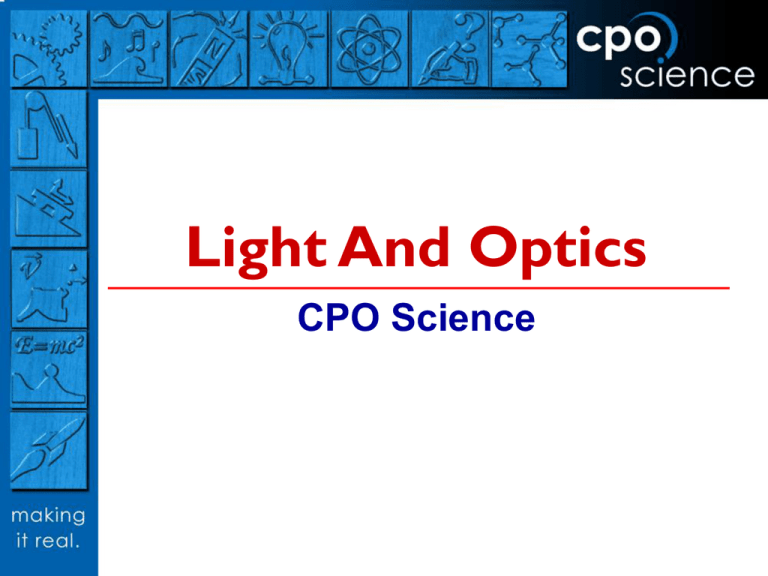Standard EPS Shell Presentation
advertisement

Light And Optics CPO Science Key Questions What is light? How can we make light? Why are there different colors of light? How does light behave in a prism? Let it glow, let it glow, let it glow Take white board and keep white side facing up. Don’t look at the bottom! When I say go, flip board over so white side is down. Place part of a hand over the square. Keep hand there! When lights go out, remove hand and observe. Atoms absorb and then emit energy with their electrons When the energy emitted falls within the visible spectrum we see it as light Charge it up with color Take out the red, blue, and green LED lights, plug them in, and use them to energize the phosphorescent paper Remove the colored lights and observe the paper with the room lights off How can you explain your observations? Light and Color How does a TV or computer monitor display many, many different colors when they start with only red, blue, and green pixels? Mix blue and green light. What color do you see? Mix red and blue light. What color do you see? Mix red and green light. What color do you see? Mix all three lights! Overview Simple Optical System (Beaker Funhouse) Reflection/Refraction in a Prism (Secret to Tic-Tac-Toe Invincibility and Prismatic Name Enlightenment) Critical Angle/Total Internal Reflection (Laser Proving Ground) What does Transparent mean? What happens? What are some examples of transparent materials? What Is an Optical System? Anything that involves light Used to study how light behaves Simple Optical System Observe the Beaker with the water and pencil in it Look at the Beaker from many different vantage points What strange or interesting things can you see involving the image of the pencil? OBSERVATIONS The pencil is bent There are two pencils There are three pencils The pencil is Magnified When you look straight down into the beaker, the pencil doesn’t seem bent Color Teaching Tool Slides Color Teaching Tool Slides Refraction/Reflection in a Prism See Page 112 in the Investigation Guide Handout for written directions Take out Prism from CPO Optics kit OBSERVATIONS I can see the X at first When I move my head up and down the X vanishes When the X vanishes the O takes its place This seems to be happening at the same angle, the “magic angle” Prismatic Name Enlightenment 1. Repeat the process for the X and O but instead of the X write your first name. 2. Also write your first name in place of the O but this time underline your name. 3. What information do you now see that can help us explain what is going on? OBSERVATIONS I can see my name upside-down When I move my head up and down my name vanishes When my upside-down name vanishes the underlined name takes its place, and it isn’t upside-down any more This seems to be happening at the same angle, the “magic angle” Time to Experiment Use a Simple Model- Laser and Prism Build Upon What You Have Learned – This Magic Angle is Critical to what is going on Setting Up Laser/Prism Experiment See Page 113 in the Investigation Guide for written directions Take out Laser from CPO Optics kit Use Graph Paper we have provided OBSERVATIONS The exiting beam exits at a different angle for each trial When I move the laser up the paper, the exiting beam angles more in the downward direction At a certain point the exiting beam disappears This seems to be happening at the same angle, the “magic angle” Conclusions from Experiment At a certain angle the beam is refracted in a direction that doesn’t exit the prism This happens at a specific angle-The CRITICAL ANGLE When the angle is bigger than the CRITICAL ANGLE the beam experiences TOTAL INTERNAL REFLECTION How We Can Use Optics in Everyday Life Fiber Optics Laser Scanners Surgical Lasers Information Storage-CDs, DVDs High precision Distance Measuring




